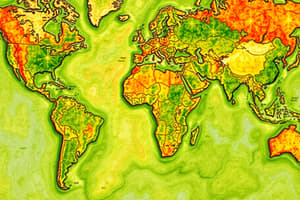Podcast
Questions and Answers
Which discipline focuses on the historical aspects and patterns of biological diversity?
Which discipline focuses on the historical aspects and patterns of biological diversity?
- Historical biogeography (correct)
- Molecular biogeography
- Urban biogeography
- Ecological biogeography
What is the primary focus of ecological biogeography?
What is the primary focus of ecological biogeography?
- Current interactions between organisms and their environments (correct)
- Geographical features that influence species location
- Evolutionary processes over time
- The fossil record of species
Which of the following best describes a major difference between historical and ecological biogeography?
Which of the following best describes a major difference between historical and ecological biogeography?
- Both examine only geographical features
- One only considers species interactions, the other does not
- One focuses solely on fossil records while the other does not
- One analyzes evolutionary changes while the other looks at modern ecosystems (correct)
Which discipline would be more interested in the effects of climate change on species distribution?
Which discipline would be more interested in the effects of climate change on species distribution?
How are historical biogeography and ecological biogeography best classified?
How are historical biogeography and ecological biogeography best classified?
Flashcards
Historical Biogeography
Historical Biogeography
The study of how the distribution of species has changed over time, taking into account factors like evolutionary history, continental drift, and climate change.
Ecological Biogeography
Ecological Biogeography
The study of how the distribution of species is influenced by current environmental conditions, including climate, habitat, and interactions with other species.
Two branches of Biogeography
Two branches of Biogeography
The two main branches of biogeography, each focusing on a different aspect of species distribution.
Importance of Biogeography
Importance of Biogeography
Signup and view all the flashcards
Combining Historical and Ecological Biogeography
Combining Historical and Ecological Biogeography
Signup and view all the flashcards
Study Notes
Historical Biogeography
- Examines the geographical distribution of species over long periods of time, tracing their evolutionary history and migration patterns.
- Focuses on the historical processes that have shaped current biodiversity patterns, including continental drift, climate change, and mass extinctions.
- Utilizes phylogenetic analyses, fossil records, and paleoclimate data to reconstruct past distributions and understand the evolutionary relationships among species.
- Aims to understand the origins and diversification of species within their geographic ranges.
- Involves identifying and tracing historical biogeographic events, such as vicariance (the splitting of a species' range due to geographic barriers) and dispersal (the movement of species across a geographic area).
- Studies the impact of past events on present-day species assemblages and the distribution of related species.
Ecological Biogeography
- Focuses on the interactions between species and their environment that influence current biodiversity patterns.
- Investigates factors like habitat suitability, resource availability, competition, predation, and disturbance regimes to explain species distributions within a geographic area.
- Explores the ecological mechanisms maintaining and changing species diversity across different habitats or ecosystems.
- Examines how species respond to environmental gradients and the factors that determine their abundance and coexistence.
- Emphasizes the influence of ecological processes such as competition, predation, and resource partitioning on species distributions and diversity.
- Considers the effects of abiotic factors like temperature, precipitation, and soil types on biodiversity.
- Studies how species interactions and environmental conditions influence the distribution of communities and ecosystems.
- Analyses how species richness and diversity vary across environmental gradients.
Studying That Suits You
Use AI to generate personalized quizzes and flashcards to suit your learning preferences.





